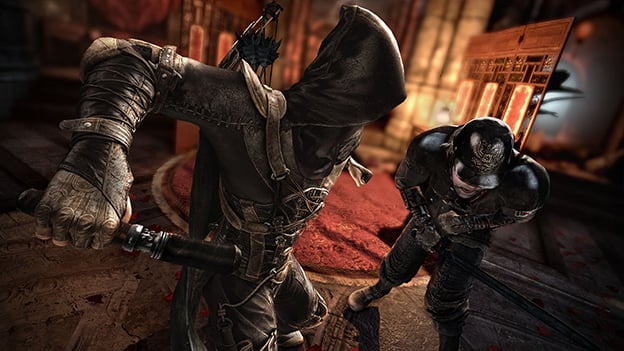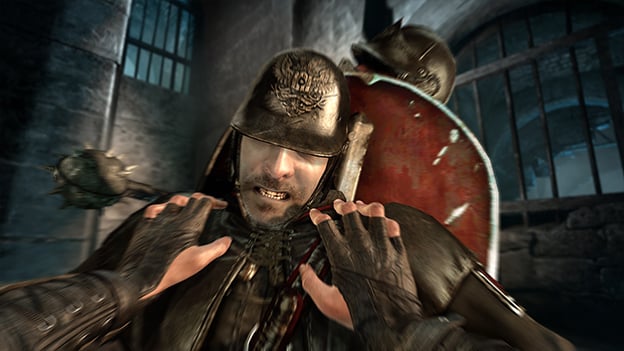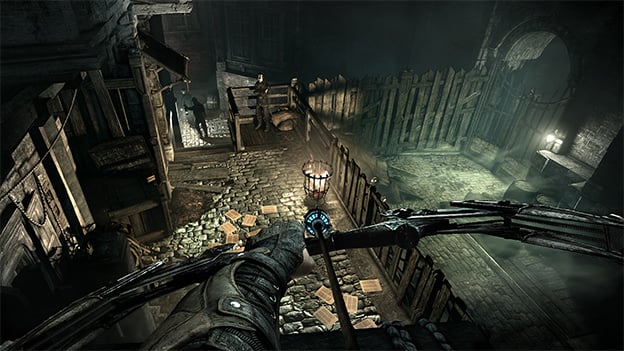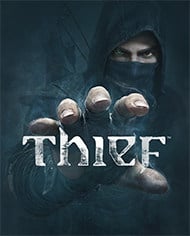Stuck in the Shadows
Remember what playgrounds used to be like? The best of them featured huge wooden and metal structures filled with dodgy activities such as ring-swinging or ziplining. They encouraged risk-taking and escapades. We’d get hurt on them sometimes—I have a large scar on one knee from one such playground incident—but by blazes, they were fun .
Thanks to insurance companies and a couple decades of paranoid helicopter parents, playgrounds aren’t much fun anymore. They’re mostly plastic and never built too high. All the hot metal and sharp edges have been carefully removed, and one park playground pretty much looks like another. It’s all safe, generic, and boring. Maybe today’s kids don’t know the difference, but I can’t help but feel bad for them, remembering how it used to be.
That’s the primary feeling I had when playing this Thief reboot, and I’m not even one of those classic gamers who worships at the altar of Looking Glass Studios. The main character Garrett is still a cynical thief, and his missions are still primarily about sneaking around, using his tools and abilities to aid his work, and stealing items for his clients. However, the City he inhabits is muted and generic, designed to lead him gently through his nocturnal misadventures, only allowing him to climb or use his arsenal of tools where the developers have deemed it appropriate.
The highly guided nature of Thief serves to constantly remind the player that they’re in a game, and the designers are in charge. Want to climb? You’ll have to find a surface helpfully marked with claw marks, out-of-place blue grates, or what I assume must be raven droppings (shades of Assassin’s Creed pigeon poop). Want to get by that foot-long pressure plate trap? Well, you can’t jump over it, who would think to do a thing like that? No, you’ll have to find another (specifically designed) way around or find a control box and cut its wires. Want to take care of that pesky guard dog? Too bad, you can’t. They’ve all been caged for their own protection… and to keep clever players from doing anything unintended to neutralize the threat.

Thus, clambering around the labyrinthine City and traversing the game’s main missions is largely a task of figuring out which choices the developers left open for the player to pursue. There are certainly some choices available, particularly within the missions themselves, but freedom is taken away from the player far too often. The game frequently boils down to a pixel hunt in order to figure out the single way to overcome a particular obstacle. It’s not always consistent, either. The exact same kind of wood bridge might need to be dropped by shooting a pulley, pulling a lever, or finding a hidden switch. Using Garret’s Focus ability, which highlights interactive elements in the scenery in glowing blue, feels like a cheap tactic that has been provided to work around this inconsistency. It’s difficult to figure out exactly what you’re allowed to do without using Focus, since the rules tend to change from puzzle to puzzle.
Is Thief a game that was simply designed for gamers who prefer being led by the hand through challenges, or is its restrictive gameplay a reflection of a troubled development period? It’s difficult to tell, though I felt like the game’s seams were showing on numerous occasions. The “open world” City is a nonsensical jumble, the mission areas feel better-designed but have large “dead” areas that feature little of interest and should have been pruned, and there are various game elements that seem borrowed from other titles with litter regard for how well they fit into this one.

There were certainly concessions made to please old-school gamers who enjoyed the original Thief series. Most of the so-called modern interface elements—visible waypoints, the blinding glint that treasure emits, the mini-map—have been made optional. It’s obvious that the game was designed around these helpful guides, however. You can try to play it like the old Thief , removing all those interface elements and refusing to use the Focus system, but why would you? The game is clearly designed around these elements, and eschewing them is largely an exercise in frustration rather than challenge.
That leads to one of the primary issues with Thief : it reboots a beloved series but never finds its own identity. The fascinating society from the original Thief games has been removed—the inventive societal factions who spoke in a colorful vernacular have been replaced by generic baddies who say “f*ck” a lot. The City itself is mired in perpetual gray-brown gloom, with technology and props that appear to have been flown in hodgepodge as though we’re on the island from LOST . It’s oddly empty for a place that’s supposed to be full of hopeless, teeming masses. They’re not on the streets, but you don’t tend to encounter them in their homes, either. It has supernatural elements (as the original series did), but the world-building isn’t good enough to support them.

Garret himself has been subjected to this reboot’s scalpel. He retains a bit of his original personality, but it’s difficult to get a handle on him due to a highly inconsistent vocal performance. It feels as though his new actor was called back repeatedly over the course of years to re-record lines. Sometimes he has a bit of a “street” accent, sometimes he doesn’t. Sometimes he feels like he’s supposed to be like the original Garret, other times he sounds like an imitation of the Man in the Suit from Person of Interest . The cries that he makes when hit by a trap sound like they were recorded by a different person entirely.
In fact, the entire sound design seems off somewhat. Conversations often sound far away, then suddenly feel like they are mere inches away when Garret turns a corner. I was driven crazy by trying unsuccessfully to locate guards by sound, until finally deciding to rely on peeking around corners or finding a high vantage point. Perhaps this issue has been fixed in the release version of the game or is unique to the PC version, but it certainly took away from the game for me.
If you can get over its artificial restraints, inconsistencies in design, and generic atmosphere, there’s fun to be had in Thief . The stealth elements are done well for the most part, and using the swoop move that allows Garrett to dart between shadows is enjoyable. There are a million treasures to plunder and the game provides challenges for players who wish to take an aggressive, stealthy, or opportunistic approach to the levels. I was personally unimpressed with these challenges, finding them simply an extension of the game’s hand-holding approach, but I can see their appeal for players who love to collect achievements.
I’ll be blunt: if you loved the original Thief series, you won’t enjoy this game. If you have never played the original Thief games, there’s some enjoyment to be had, but there are other stealth-heavy games around that are a far better overall package than this one. Thief has a few good ideas, but they’re dragged down by the game’s design as a whole. With available games that let us freely scale the outside of those wooden castles of old, why should we settle for one that sticks us on a plastic kiddy playground?
RATING OUT OF 5 RATING DESCRIPTION 3.0 Graphics
Grey-brown and murky for the most part, though the shadows are excellent. 3.5 Control
The game works well, but only due to extreme restrictions on where Garret can go and what he can do. 2.0 Music / Sound FX / Voice Acting
I encountered serious issues with the sound design and the consistency of Garret’s voice performance. 2.9 Play Value
There’s a lot of game here, but is it compelling? 2.9 Overall Rating – Average
Not an average. See Rating legend below for a final score breakdown.
| Review Rating Legend | |||
|---|---|---|---|
| 0.1 – 1.9 = Avoid | 2.5 – 2.9 = Average | 3.5 – 3.9 = Good | 4.5 – 4.9 = Must Buy |
| 2.0 – 2.4 = Poor | 3.0 – 3.4 = Fair | 4.0 – 4.4 = Great | 5.0 = The Best |
Game Features:
